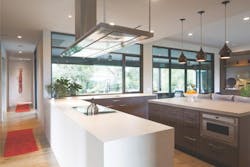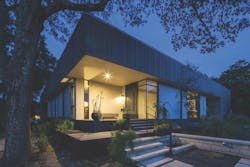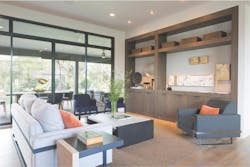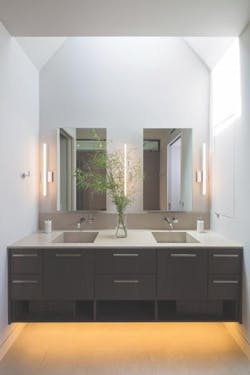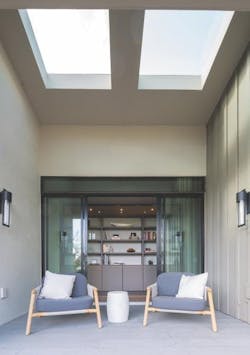When designing her own home from the ground up, Austin, Texas-based designer Laura Britt, ASID, wanted to build a LEED Platinum-certified house that uses net-zero energy, harvests rainwater, and provides an urban wildlife habitat. But she also wanted the healthiest house possible. For her, that meant paying special attention to indoor air quality (IAQ).
Britt has a sensitive respiratory system and has experienced intense reactions to off-gassing from finishes. Her young son is also prone to respiratory ailments. “We wanted to make the air in our home as clean as we could,” says Britt, who brought 25 years of experience to the 2,750-square-foot, three-bedroom project.
In the kitchen, Dekton by Cosentino quartz countertops provide a hard-wearing surface free of chemical binding agents, and formaldehyde-free cabinet boxes are faced with rift-cut walnut veneer.
For guidance on IAQ and other aspects of a healthy building, Britt looked to the WELL Building Standard, a certification system administered by the International WELL Building Institute that optimizes the built environment for human health. Although the WELL standard is geared toward commercial offices and doesn’t offer certification for single-family homes, it does provide a comprehensive framework that includes air quality, water purity, and acoustic and thermal comfort.
“We wanted to make the air as clean as we could.” — Designer and homeowner, Laura Britt
Considering air quality from the starting point of the home’s layout, Britt designed an open-air carport, which—unlike a garage—keeps pollutants from car exhaust outside. Clad in stucco and HardiePlank siding to match the house, the vine-screened structure also doubles as a pavilion for outdoor entertaining and a place for kids to play.
The Austin, Texas, home focuses on energy efficiency, water conservation, and indoor air quality.
Another important component is the home’s HVAC system, a high-efficiency variable refrigerant flow (VRF) system that’s coupled with a whole-house ventilating dehumidifier to bring in fresh, filtered air every half-hour. The home’s air quality is monitored using Foobot IAQ devices that measure volatile organic compounds (VOCs) and particle pollutants.
Britt also took control of the finishes and furnishings going into her home. In addition to running her design firm, Laura Britt Design, she has 10 years of experience designing and producing custom eco-friendly furniture, which uses foam without flame retardants for upholstered pieces and low- and no-VOC adhesives and finishes.
Furnishings and finishes throughout the home are environmentally friendly.
“We’re really committed to the process and the outcome, and it pushes the industry forward when you ask tough questions,” Britt says. As part of her research, she traveled to Spain to observe the manufacture of Dekton by Cosentino surfacing, a sintered engineered stone produced using heat and pressure rather than chemical binding agents, which led her to select it for her kitchen and bath countertops.
After living in the new house for a couple of years, Britt is no longer experiencing debilitating cases of bronchitis and walking pneumonia. She is now building a new office for her design company and intends to pursue WELL certification for that project. Says Britt: “We’ve learned some good lessons, and are excited to continue putting them into practice by applying them to our new office.”
This story originally appeared in the Winter 2019 issue of PRODUCTS magazine. See the print version here.
